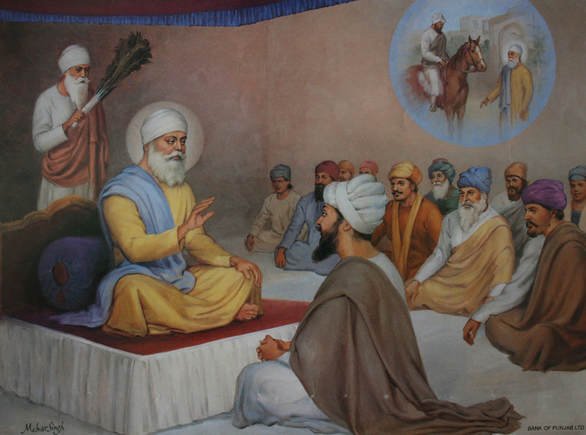This is Part III of VIII in the series ~ "To See the World Through the Guru's Eyes"
Read Part I here
Read Part II here
Deep meditation is not a part of everyone's daily experience. The saints who wrote Gurbani also devoted a good deal of their inspiration to depicting the details of their inner communion. They used distinctive terminology that may today be referenced as guideposts, allowing us today to navigate the sacred realm of profound meditation.
This terminology may be divided into four categories. Elements from each were freely combined, conveying several dimensions of the sublime reality of meditation. These categories are:
- Conceptual: Terms such as ‘The One,’ duality, three gunas, ‘three worlds’ (animal, human, divine), Turiaa, the ‘five thieves’ (lust, anger, greed, pride, attachment), and samadhi situate the meditative experience within parameters and using definitions found in Indian tradition of philosophy and psychology.
- Locational: Terms such as the ‘tenth gate’ (at the top of the head), the ‘city of Shiva’ (the brain), the forehead, tribeni, ‘lotus of the mind,’ and ‘cave of being’ (the skull), describe that experience as it relates to physical and metaphysical aspects of the body.
- Physiological: The main physiological reference in Gurbani is to the ‘flow of Amrit (ambrosia).’ While open to interpretation, these references readily correlate with the brain's secretion of gamma-aminobutyric-acid (GABA), dopamine, melatonin, and other neurochemicals associated with meditation.
- Subjective: Terms such as the Anahat Shabad (unstruck Word), Shun (neutral mind), Anand (spiritual bliss), Surat (meditative awareness) and Nirvana depict purely subjective components of the experience of deep meditation. Not much can be objectively said about these. Kabir describes the ineffability of meditative experience to a mute person’s experience of eating sugar. How can they ever communicate what they are experiencing?
This terminology occurs many hundreds of times in Gurbani. Following are a few excerpts of this genre which demonstrate both the richness of the artistry and the continued passing on of the experience of meditation from Guru to disciple.
Guru Nanak:
ਉਲਟਿਓ ਕਮਲੁ ਬ੍ਰਹਮੁ ਬੀਚਾਰਿ ॥
उलटिओ कमलु ब्रहमु बीचारि ॥
Ulti▫o kamal barahm bīcẖār.
ਅੰਮ੍ਰਿਤ ਧਾਰ ਗਗਨਿ ਦਸ ਦੁਆਰਿ ॥
अम्रित धार गगनि दस दुआरि ॥
Amriṯ ḏẖār gagan ḏas ḏu▫ār.
Through meditation on the Creator, the Lotus of the mind has come upright.
Amrit pours from the sky of the Tenth Gate. The Lord himself pervades the three worlds. (Siri Guru Granth Sahib, 153)
ਅਦਿਸਟੁ ਦਿਸੈ ਤਾ ਕਹਿਆ ਜਾਇ ॥
अदिसटु दिसै ता कहिआ जाइ ॥
Aḏisat ḏisai ṯā kahi▫ā jā▫e.
ਬਿਨੁ ਦੇਖੇ ਕਹਣਾ ਬਿਰਥਾ ਜਾਇ ॥
बिनु देखे कहणा बिरथा जाइ ॥
Bin ḏekẖe kahṇā birthā jā▫e.
ਗੁਰਮੁਖਿ ਦੀਸੈ ਸਹਜਿ ਸੁਭਾਇ ॥
गुरमुखि दीसै सहजि सुभाइ ॥
Gurmukẖ ḏīsai sahj subẖā▫e.
ਸੇਵਾ ਸੁਰਤਿ ਏਕ ਲਿਵ ਲਾਇ ॥੨॥
सेवा सुरति एक लिव लाइ ॥२॥
Sevā suraṯ ek liv lā▫e. ||2||
If the invisible could be seen with these eyes, it would surely be seen. And without seeing, there is no use in speaking of it.
The enlightened one spontaneously sees what others do not and serves with a meditative awareness. (Siri Guru Granth Sahib, 222)
ਸਿਵ ਨਗਰੀ ਮਹਿ ਆਸਣਿ ਬੈਸਉ ਕਲਪ ਤਿਆਗੀ ਬਾਦੰ ॥
सिव नगरी महि आसणि बैसउ कलप तिआगी बादं ॥
Siv nagrī mėh āsaṇ baisa▫o kalap ṯi▫āgī bāḏaʼn.
ਸਿੰਙੀ ਸਬਦੁ ਸਦਾ ਧੁਨਿ ਸੋਹੈ ਅਹਿਨਿਸਿ ਪੂਰੈ ਨਾਦੰ ॥੨॥
सिंङी सबदु सदा धुनि सोहै अहिनिसि पूरै नादं ॥२॥
Sińī sabaḏ saḏā ḏẖun sohai ahinis pūrai nāḏaʼn. ||2|
Leaving off schemes and contentions, in the city of Shiva, the Yogi takes up his meditative posture.
The horn of the unstruck Word constantly makes celestial music, day and night in perfect tune. (Siri Guru Granth Sahib, 360)
ਅਲਿਪਤ ਗੁਫਾ ਮਹਿ ਰਹਹਿ ਨਿਰਾਰੇ ॥
अलिपत गुफा महि रहहि निरारे ॥
Alipaṯ gufā mėh rahėh nirāre.
ਤਸਕਰ ਪੰਚ ਸਬਦਿ ਸੰਘਾਰੇ ॥
तसकर पंच सबदि संघारे ॥
Ŧaskar pancẖ sabaḏ sangẖāre.
The enlightened one lives free in the pristine cave of being.
There, using the power of the Word, he does away with the five thieves. (Siri Guru Granth Sahib, 904)
ਸੁੰਨ ਸਮਾਧਿ ਸਹਜਿ ਮਨੁ ਰਾਤਾ ॥
सुंन समाधि सहजि मनु राता ॥
Sunn samāḏẖ sahj man rāṯā.
ਤਜਿ ਹਉ ਲੋਭਾ ਏਕੋ ਜਾਤਾ ॥
तजि हउ लोभा एको जाता ॥
Ŧaj ha▫o lobẖā eko jāṯā.
With their mind easily absorbed in the samadhi of the neutral mind,
Giving up selfishness and greed, they recognize only the One. (Siri Guru Granth Sahib, 904)
Guru Angad:
ਨਉ ਦਰਵਾਜੇ ਕਾਇਆ ਕੋਟੁ ਹੈ ਦਸਵੈ ਗੁਪਤੁ ਰਖੀਜੈ ॥
नउ दरवाजे काइआ कोटु है दसवै गुपतु रखीजै ॥
Na▫o ḏarvāje kā▫i▫ā kot hai ḏasvai gupaṯ rakẖījai.
ਬਜਰ ਕਪਾਟ ਨ ਖੁਲਨੀ ਗੁਰ ਸਬਦਿ ਖੁਲੀਜੈ ॥
बजर कपाट न खुलनी गुर सबदि खुलीजै ॥
Bajar kapāt na kẖulnī gur sabaḏ kẖulījai.
There are nine gates to the body castle. The tenth is kept well hid.
That stubborn gate is shut tight, but with the Guru’s Word it opens. (Siri Guru Granth Sahib, 954)
Guru Amar Das:
ਤ੍ਰੈ ਗੁਣ ਮਾਇਆ ਮੋਹੁ ਹੈ ਗੁਰਮੁਖਿ ਚਉਥਾ ਪਦੁ ਪਾਇ ॥
त्रै गुण माइआ मोहु है गुरमुखि चउथा पदु पाइ ॥
Ŧarai guṇ mā▫i▫ā moh hai gurmukẖ cẖa▫uthā paḏ pā▫e.
From being lost in the grip of the enchanting three gunas,
The enlightened one realizes turiaa, the fourth state. (Siri Guru Granth Sahib, 30)
Guru Ram Das:
ਨਉ ਦਰਵਾਜ ਨਵੇ ਦਰ ਫੀਕੇ ਰਸੁ ਅੰਮ੍ਰਿਤੁ ਦਸਵੇ ਚੁਈਜੈ ॥
नउ दरवाज नवे दर फीके रसु अम्रितु दसवे चुईजै ॥
Na▫o ḏarvāj nave ḏar fīke ras amriṯ ḏasve cẖu▫ījai.
There are nine gates. Tasteless is the taste of these nine openings.
Amrit is extracted from the tenth. (Siri Guru Granth Sahib, 1323)
Guru Arjan:
ਗੁਝੜਾ ਲਧਮੁ ਲਾਲੁ ਮਥੈ ਹੀ ਪਰਗਟੁ ਥਿਆ ॥
गुझड़ा लधमु लालु मथै ही परगटु थिआ ॥
Gujẖ▫ṛā laḏẖam lāl mathai hī pargat thi▫ā.
The unmanifest Beloved, I have found. He has become manifest on my very brow.
ਅਪ੍ਰਤੱਖ ਪ੍ਰੀਤਮ ਮੈਂ ਪਾ ਲਿਆ ਹੈ। ਉਹ ਮੇਰੇ ਮਸਤਕ ਤੇ ਹੀ ਜ਼ਾਹਰ ਹੋ ਗਿਆ ਹੈ।
ਸੋਈ ਸੁਹਾਵਾ ਥਾਨੁ ਜਿਥੈ ਪਿਰੀਏ ਨਾਨਕ ਜੀ ਤੂ ਵੁਠਿਆ ॥੩॥
सोई सुहावा थानु जिथै पिरीए नानक जी तू वुठिआ ॥३॥
So▫ī suhāvā thān jithai pirī▫e Nānak jī ṯū vuṯẖi▫ā. ||3|
The jewel that was hidden has been found. It has appeared on my brow.
Beautiful and holy is that place, O Nanak, where you dwell, O my dear Lord! (Siri Guru Granth Sahib, 1096)
Guru Tegh Bahadur:
ਉਸਤਤਿ ਨਿੰਦਾ ਦੋਊ ਤਿਆਗੈ ਖੋਜੈ ਪਦੁ ਨਿਰਬਾਨਾ ॥
उसतति निंदा दोऊ तिआगै खोजै पदु निरबाना ॥
Usṯaṯ ninḏā ḏo▫ū ṯi▫āgai kẖojai paḏ nirbānā.
ਜਨ ਨਾਨਕ ਇਹੁ ਖੇਲੁ ਕਠਨੁ ਹੈ ਕਿਨਹੂੰ ਗੁਰਮੁਖਿ ਜਾਨਾ ॥੨॥੧॥
जन नानक इहु खेलु कठनु है किनहूं गुरमुखि जाना ॥२॥१॥
Jan Nānak ih kẖel kaṯẖan hai kinhūʼn gurmukẖ jānā. ||2||1||
Give up praise and blame. Seek instead the state of nirvana. Servant Nanak says, this is such a difficult game.
Only a few enlightened ones understand it. (Siri Guru Granth Sahib, 219)
In this selection of quotes, we see a variety of depictions of inner awareness using conceptual, locational, physiological, and subjective terminology. While this Gurbani may sound mystical and strange to anyone unfamiliar with the vocabulary, to a meditator they are masterful expressions and directions on the path of inner experience.







